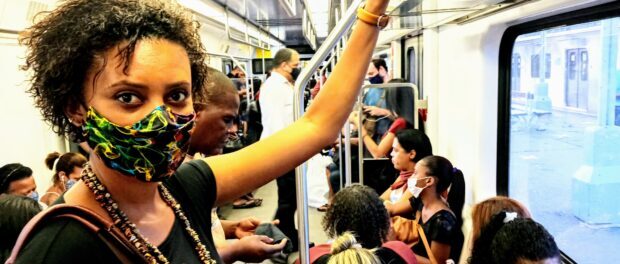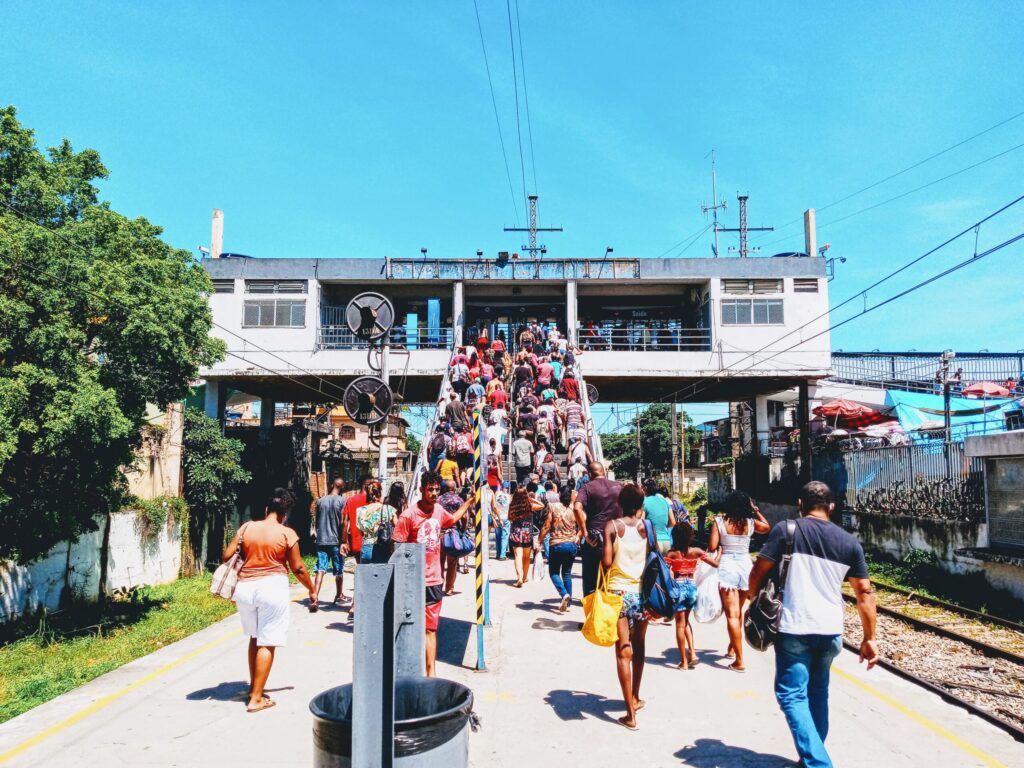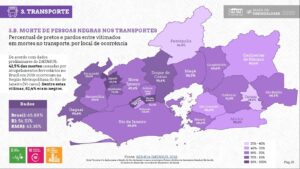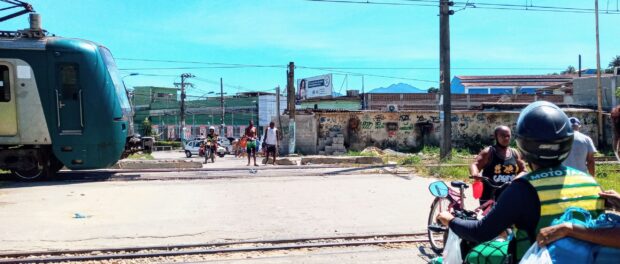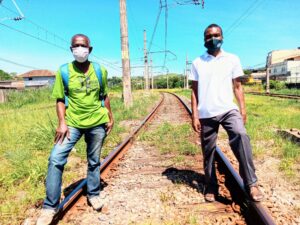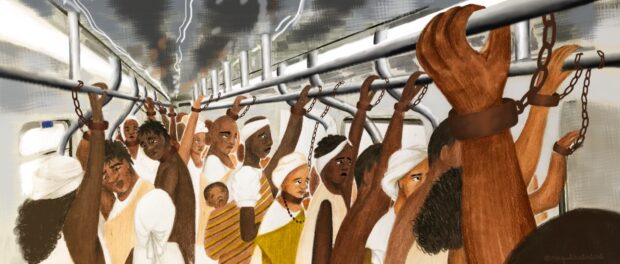
This article is the latest contribution to our year-long reporting project, “Rooting Anti-Racism in the Favelas: Deconstructing Social Narratives About Racism in Rio de Janeiro.” Follow our Rooting Anti-Racism in the Favelas series here.
Racism is also impregnated in policies of urban mobility. What impacts does this have on the black, poor, peripheral population of Greater Rio’s Baixada Fluminense?
Racism possesses several variables, it is present in practically all fields of knowledge and areas of society. It is impossible to analyze mobility racism solely under the lens of racism. What we need is to plot a brief history of a public policy that affects the lives of thousands of people every day, especially those included in the 13 municipalities of Greater Rio de Janeiro’s Baixada Fluminense region—that has lived decades with a suburban rail system that tries, to no avail, to bring “modernity” to this group of territories. Mistakes (d)effects, demagogy, and even the violation of rights are everyday routine in the lives of over three million people, most of them black, poor, and peripheral. We opted to narrate their misadventures through users of the longest line of Rio’s SuperVia suburban rail system: the Central do Brasil-Japeri line.
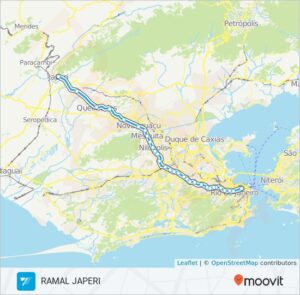
Speaking about the Baixada Fluminense from the point of view of the trains means returning to the infancy of the country’s economic development. During the first half of the 20th century, the emergence of the railway system was the springboard for dozens of stations from which towns, villages, and cities were born. Municipalities such as Nova Iguaçu, Duque de Caxias, and Itaguaí, for instance, would not exist had it not been for the railroad. Starting with the great urban revolution that began around 1950, with the irreversible move from country to city, the growth of towns that were close to large urban centers sped up. This brought the rise of bedroom communities—a consequence of the lack of local jobs and a strong dependence on the then nation’s capital.
“At some point, the trains that connected these municipalities started to be called suburban trains and their passengers became the masses of workers that moved back and forth between home and work everyday, on trips that were increasingly longer and farther,” writes José Cássio Ignarra in his master’s thesis The Process of Decentralization and Statization of the Metropolitan Train Systems in Brazil and its Impacts on the Instruments of Management and Coordination of Metropolitan Public Policies, through the Getúlio Vargas Foundation.
In 2018, 42.5% of train-pedestrian fatalities in Brazil happened in the Greater Rio metropolitan area (91 cases). Among these victims, 82.4% were black.
Lilian Barbosa was born and raised in Japeri. A social worker, researcher, poet, and master’s student at the Federal University of Rio de Janeiro (UFRJ), she is extremely aware of what she suffered to get the undergraduate degree she dreamed of while working and needing SuperVia’s trains to get around. With an estimated population of over 105,000 inhabitants, according to data collected by Brazil’s national statistical agency, IBGE, in the last census (2010) the municipality of Japeri possesses a single bus line and the train line as the only modes of transport to get to Rio de Janeiro proper. Exactly 61.75 km separate the two cities, covering 17 stations on a trip that takes, on average, over two hours. The inefficiency of the transportation system coming out of Japeri has resulted in many disruptions that had a direct effect on Lilian’s daily life.
“I was held back a semester due to the time I’d arrive at the university because of the train delays at the beginning of the 2000s. I had to deal with a lot of prejudice, including from classmates who kept saying I should get up earlier to get to school. But what those people didn’t know was that, as it was, I took the first train out. Attending university made me a trailblazer in my family. Being a black, poor, peripheral woman, I went against the statistics. Still, traveling to and from the Baixada, considering the enormous territory it covers, its diversity, and the distance between municipalities, makes the trips tiring,” says Lilian.
Exhaustion is similarly part of Kelly Martins’ vocabulary, an administrative assistant who also lives in Japeri. At 36, she has already spent half her life depending on SuperVia trains. Physical and emotional tiredness, particularly as a result of the distances traveled, are some of the factors that weigh her down. The Covid-19 pandemic brought on the deterioration of her mental health. Dealing with people who are constantly negligent with safety protocols, such as wearing face masks inside train cars, stresses her out. Kelly also identifies the racism of the railroad system.
“This is a mode of public transport in which racism is everywhere. From the passengers, to the informal vendors. Almost all are black. You can actually make an analogy with slavery. Some time ago, trains had a device that prevented people from falling down, which were the ‘pacifiers’ (large metal rings on which standing passengers held on and tried to balance themselves during the bumps of the long journeys). That, to me, is the slave quarters themselves. If you consider that you are on a crowded train, unable to move properly, with people bumping into you after a tiring day at work, often dying of heat without the comfort of air conditioning, it’s not much different from a slave ship. I can’t see much of a difference,” says Kelly.
But is this analogy an exaggeration? Is it possible to make a comparison, even if metaphorical, between Rio de Janeiro’s public transport railway network and one of the most perverse forms of the diaspora (the forced dispersion of a people from their territory of origin) known to mankind? If we were to focus on a more contemporary look at the SuperVia trains, it is possible that one improvement or another could be considered “satisfactory” nowadays. The trains are cleaner, the doors actually close, for example. But let us focus on one of the most obvious indicators of this controversy: overcrowding. It is clear that the extent of all the forms of cruelty imposed on the enslaved populations coming from African countries from the 15th century on is stomach-churning in terms of the proportionality of physical and psychological damages. However, when talking about “space optimization” on slave ships, the similarities are more plausible. If on slave ships, entire families were subjected to degrading environmental aberrations, this was due, among other evils, to the minimal conditions to fit the largest possible number of slaves.
SuperVia has never chained, tortured, or thrown dying passengers to the rails during its train rides as was the case on those death ships (though they have struck them with whips). But it is clear that for decades before privatization in 2007, the scene was dramatically chaotic and dangerous. Look at any archival image from before the new operator ran the railroad to see that, metaphors aside, crowded black bodies heading to work were routine. In 2013, six years after the rail network changed hands and became privately managed, a story in the Extra newspaper reported, for example, that “a man fell off a SuperVia train this Friday morning, at the Vila Militar station, in Rio’s West Zone. The car was overcrowded. The man—who allegedly boarded in Padre Miguel—was hanging from the door and unable to hold on.”
Muito cheio ó trem Japeri olhar isso pic.twitter.com/oghEl3vN1e
— Sérgio Fernandes (@SrgioFe59592225) July 22, 2020
Tweet by Sérgio Fernandes: The Japeri train is very full. Take a look.
Racism, ‘Development’ and ‘Industrialization’
Lack of public investment for maintenance and expansion made the SuperVia railway transport lose strength in the 1990s. With the priority, at the time, geared towards buses—which included a heavy and widely known political lobby investigated for numerous illegalities (and which was also responsible for electing mayors in many municipalities)—the railway system underwent a deep crisis. The Brazilian Urban Trains Company (CBTU), which carried one million passengers a day in 1984, underwent a degree of degradation that affected the safety of operations (leading to accidents), punctuality, trust, safety from crime and cleanliness of stations and trains. This brought on such a constant and brutal drop in the number of passengers that by 1996 there were only 145,000 per day.
Vídeo mostra momentos após problemas técnicos em um trem do ramal Japeri próximo da estação Engenho de Dentro. Passageiros tiveram que descer do trem em um espaço curto próximo ao muro da linha férrea. Que situação hein Supervia 😒 pic.twitter.com/wq8geljKDG
— Padre Miguel News (@PadreMiguelNews) July 9, 2019
Padre Miguel News Tweet: Video shows moments following technical problems with a Japeri train near the Engenho de Dentro station. Passengers had to get off on a narrow stretch, close to the railway wall. What a mess, huh, SuperVia?
When looking at investments made during the railway system’s privatization process, however, the data seem to outweigh our perception of development. In all, between the administrations of governors Sérgio Cabral and Luis Fernando Pezão, starting in 2007, 142 trains were bought with funds left over from a US$600 million loan received from the World Bank in a public-private partnership made with SuperVia which had, at the time, Odebrecht TransPort and the state government of Rio as majority shareholders.
With so many zeros to the right of that comma, the city of Rio and Baixada Fluminense should have been supplied with one of the best railway systems in the world. What went wrong, then? A possible answer may be in a brief text produced by philosopher and legal expert Silvio Almeida in his book Structural Racism, an instant classic for its clear and concise explanation of the many facets that make up the racist society of which we are a part.
In tackling the themes of racism and of economic development, Silvio Almeida writes: “Industrialization did not result in income distribution and in well-being for the population. Without income distribution, industrialization and the growth of the population became expressions of a ‘conservative modernization’ which, in the name of maintaining inequality and the concentration of wealth, required the suppression of democracy and of the exercise of one’s rights as a citizen, and covering up social conflict, including those of a racial nature. The ideology of a false racial democracy played a crucial role in this process. Racism is not a mere reflection of archaic structures that could be overcome with modernization, for modernization is also racist.”
A Company with a ‘License to Kill’
Casa Fluminense is a civil society organization that supports public policies and actions which improve the quality of life in the Greater Rio metropolitan region. It is also one of the coordinators of the 2020 Inequality Map, a grouping of data, statistics and socioeconomic indicators—including public transport—produced for the state of Rio de Janeiro. On the map, the areas making up the Baixada Fluminense present some of the most striking discrepancies at play regarding the region’s reality.
For Casa Fluminense’s Guilherme Braga, even after it was announced that the Rio de Janeiro railway network would receive a significant amount of funding, it still felt like quality of the service was shockingly insufficient. “Since the announcement of the Rio de Janeiro Olympic Games, city trains have received the least amount of funding among public modes of transport, though the invested amount has exceeded almost R$1 billion. In other words, the perpetuation of the stereotype, in the last thirty years, surrounding Rio de Janeiro’s suburban zones and peripheral municipalities, areas which are mostly black and poor, is that standards which guarantee quality transport are not necessarily obligatory. It is an exclusive, classist, and racist arrangement. A great indicator of the decline of the service are the gaps between trains and platforms. The subway, a mode of transport designed for the white middle class, is held to adequate standards. In SuperVia, the gap between the train and the platform, in certain stations, is like an abyss. A person can fall down and die.”
In fact, people do die in SuperVia stations. The 2020 Inequality Map also collected data that laid bare the necropolitics of the Rio de Janeiro public transport system. Supported by figures released by DataSUS, 42.5% of deaths caused by railroad accidents in Brazil in 2018 occurred in the Rio de Janeiro metropolitan area, amounting to 91 cases. Among these victims, 82.4% were black.
One of the victims was Joana Bonifácio Gouveia, 19, a black university student living in São João de Meriti. Gouveia passed away on April 24, 2017, in the Coelho da Rocha station, which belongs to the Belford Roxo branch. When trying to get on the train, one of her legs got trapped in the doors, so she lost her balance, fell into the gap between the train and the platform, and was soon after run over. Gouveia was on her way to university in Campo Grande, a neighborhood in Rio de Janeiro’s West Zone, where she studied biology. Her journey to get to university usually took two hours and twenty minutes. With time, the cause of the accident has changed, according to official sources. In its first statement, SuperVia claimed she had committed suicide. It was later discovered that this was a common argument, used in similar cases. And if it is recurrent, it is not an accident.
A year after Gouveia’s death, the investigation was still ongoing. For an Agência Pública piece, the Public Security Institute (ISP), an entity linked to the Rio de Janeiro state government, collected other data related to this type of death on SuperVia’s railway lines. Looking solely at cases of railway accidents occurring in municipalities where SuperVia trains run, we see that in 2017, the year in which Gouveia died, there were 66 other cases—30 more than in 2016, and 41 more than 2015. In total, from 2008 to 2017, there were 285 cases of involuntary manslaughter as a result of railway accidents, and 138 cases of culpable injury caused by railway accidents in neighborhoods cut by SuperVia trains.
In Japeri, Urban Mobility Does Not Meet the Population’s Needs
Introducing themselves as the extreme antithesis to Rio’s all-powerful railway network operator, a humble collective of Japeri residents, concerned with giving a more humane aspect to the local population’s public transport, has been coordinating with the city’s administration for improvements since 2015. With four other people, Carlos Evandro founded the Mobilize Japeri Association which, one year after its founding organized a lecture boasting the participation of residents’ associations from the city’s peripheral neighborhoods, with the cooperation of the Institute for Transportation and Development Policy (ITDP), whose mission is to promote environmentally sustainable and equitable transportation all over the world.
At the time, one of the themes on the agenda dealt with changes to the city’s long-term master plan, and, among these, upgrading the stations of Engenheiro Pedreira and Japeri based on the concept of Transit-Oriented Development (TOD). Outside the set of premises that encompass TOD, Japeri, like so many of the country’s urban areas, grew as an urban sprawl, sectorizing different parts of the city. This growth model resulted in socially segregated cities, with a negative impact on their socio-economic development.
“We don’t have a large enough number of bus lines to meet the needs of the city’s periphery. Since most of the roads leading to their neighborhoods haven’t been paved, vehicles get damaged, take longer to arrive, longer to get to their destination, which makes it’s harder for poor residents to get to faraway jobs. Besides, we become very dependent on moto-taxi services. I have nothing against these workers, but this mode of transportation is neither comfortable nor safe. It limits traveling distances, particularly for the elderly,” Carlos Evandro explains.
Another change in the master plan which could make the lives of Japeri residents easier—but which, at the same time, would expose the entrails of a lawless city—would be setting up a pedestrian walkway in the center of Engenheiro Pedreira, one of the town’s districts, where there is currently a boom barrier. After a few accidents with cars and pedestrians hit, SuperVia determined the crossing be closed, walling it off on both ends. The municipal administration promised to build an overpass where there was a level crossing.
Patrícia Alves, another representative of Mobilize Japeri, explains what happened, “The problem is that the overpass was built almost one kilometer from where had been agreed, in the neighborhood of São Jorge. So the boom barrier was slowly damaged and repaired by SuperVia successively, until it was finally reopened, illegally, in the middle of the night, with a tractor on the sidewalk, and then the company gave up fixing it. Now, with no means of control, small cars, moto-taxis and pedestrians go back and forth through a stretch that has no sound devices warning the approach of a train. Conductors sound the train whistles in order to avoid a tragedy.”
According to Jacques Kwangala—coordinator of the Afro-Brazilian Pastoral Association and vicar of Engenheiro Pedreira’s Our Lord of Bonfim Church—the colonial and slave-owning logics that have perpetuated themselves to this day obtain significant advantages in building the periphery’s “ignorance” in facing public authorities to deal with their own problems. About this lack of understanding of how public policies should be better discussed and of being able to rely on more ample participation of the black, poor and peripheric population, Kwangala says: “While we live in a society that is based on a European monoculture, that does not prize black culture, that is based on the privileges inflicted by whiteness and that constantly denies its racial diversity and its economic plurality, we will not be building mere trains but iron coffins with living black people in them. If we insist on thinking solely with our individuality, we will continue to be enslaved by backwardness.”
About the author: Fabio Leon is a journalist, human rights activist, and media advisor for the Fórum Grita Baixada.
About the artist: Raquel Batista is a visual artist and works as a photographer and illustrator. A black woman, resident of Rio’s West Zone, she is an undergraduate at UFRJ’s School of Fine Arts.
This article is the latest contribution to our year-long reporting project, “Rooting Anti-Racism in the Favelas: Deconstructing Social Narratives About Racism in Rio de Janeiro.” Follow our Rooting Anti-Racism in the Favelas series here.

